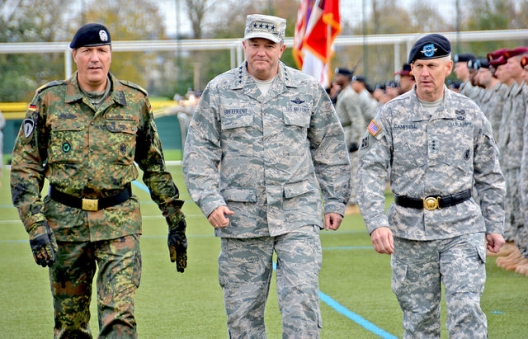 If there was any doubt of the relevance of NATO before now, the last few months have cleared that up and reinforced the need for our essential core tasks: Collective Defense, Cooperative Security and Crisis Management. . . .
If there was any doubt of the relevance of NATO before now, the last few months have cleared that up and reinforced the need for our essential core tasks: Collective Defense, Cooperative Security and Crisis Management. . . .
THE CRISIS in Ukraine has highlighted that our current approach to readiness does not necessarily translate into responsiveness. We will need to evolve certain aspects of the Alliance in order to become more adaptive and responsive to future challenges. Our immediate assurance measures – for example, sending additional aircraft to enhance Air Policing over the Baltic States or by providing Patriot missiles in Turkey – contribute to the Alliance’s coherent strategic approach to reassurance and deterrence.
These assurance measures are meaningful, incremental, and flexible with strategic depth, breadth and clear purpose. They are proportional to the general threat situation and are fundamental to maintaining a sustainable strategic effect for the Alliance.
ONE OF the key decisions made at the NATO Wales Summit was to implement a Very High Readiness Joint Task Force, or VJTF.
The VJTF is one part of a series of adaptation measures approved by Heads of State that will enable the Alliance to address the threats against our NATO Allies and the diverse challenges to Alliance security from all directions, including from the south.
Continuous Air, Land, and Sea presence and meaningful military activity are required to provide the necessary assurance, demonstrate Alliance resolve, and the defensive nature of the Alliance.
We can anticipate that our assurance measures will not go unchallenged. We can expect reaction and counter-measures intended to reduce the effect of our actions and apply pressure to test the cohesion of the Alliance.
Beyond the situation in Ukraine, there are many security challenges that face us today. The activity in Iraq and Syria by extremists calling themselves the Islamic State represents one of the biggest threats right now. We also need to consider threats to our Southern flank, Patriot deployments to Turkey, on-going operations in Afghanistan and Kosovo, cyber security challenges, and other potential actions will continue to require our attention. NATO must be able to do multiple operations simultaneously and we must plan to respond appropriately to all of these as we move forward.
The VJTF, thus, will be designed to respond to threats facing the entire Alliance including significant threats in our southern area, emanating from the Middle East and North Africa. These threats are fundamentally different and therefore our approach to address them will require a completely different solution in the south than in the east, maybe even based around a maritime headquarters.
General Philip M. Breedlove, United States Air Force, Supreme Allied Commander Europe (SACEUR), NATO Allied Command Operations.
Image: SACEUR Gen. Philip Breedlove in Weisbaden, Germany, Nov. 4, 2014 (photo: Karl Weisel/US Army)
